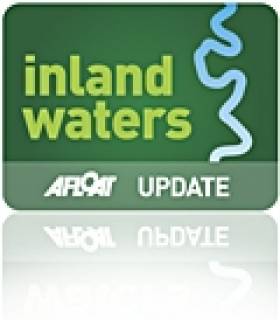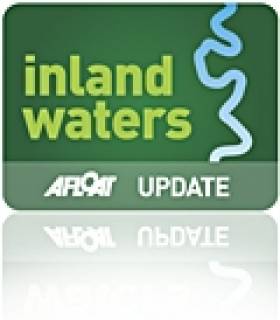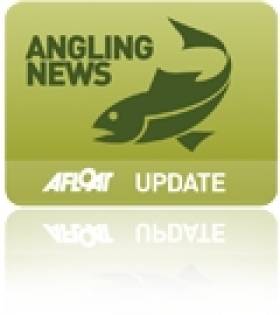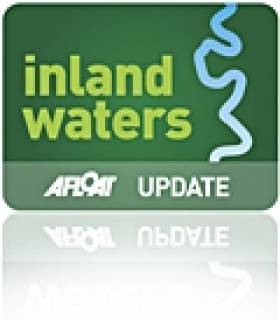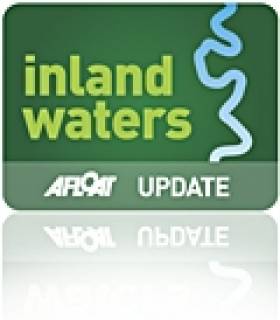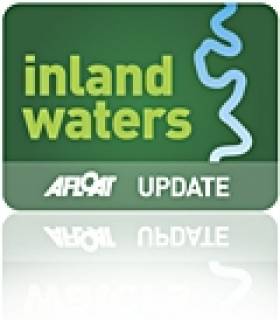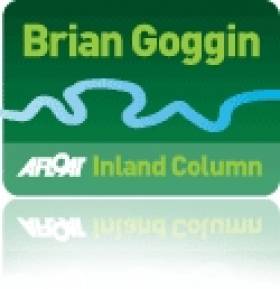Displaying items by tag: inland waterways
Grand Canal Restrictions in Tullamore Extended
#InlandWaterways - Waterways Ireland advises masters and owners of vessels that the closure of the Grand Canal from the Kilbeggan Bridge to Cox's Bridge in Tullamore has been extended from 4 March until 15 March 2013.
There will restricted navigation from the 26th Lock to the Kilbeggan Bridge due to reduced water levels of between 300mm and 400mm in this section of the canal.
The closure will facilitate Tullamore Town Council’s construction of three footbridges and a new board walk in the Tullamore area.
Notice: Inspection Of Lock Chambers & Weirs On Shannon Erne Waterway
#InlandWaterways - Waterways Ireland wishes to advise masters of vessels on the Shannon Erne Waterway that the inspection of lock chambers and weirs is presently underway and will be completed on Friday 1 March.
Masters approaching locks should be prepared to stop short and await instructions from the dive safety officer before proceeding.
Powerboat Flotilla to Visit Drogheda & River Boyne
#drogheda – Up to 20 boats will visit the town on Saturday the 13th of April and along with the Drogheda Port pilot boats, the Clogherhead RNLI Lifeboat and the River Rescue Boats the flotilla will arrive and berth at the Mall close to the De Lacey Bridge in Drogheda Town centre for high tide at 12.45 p.m.
The Inland Waterways Association (IWAI) will make its inaugural visit to Drogheda Port and Town with a large number of rigid inflatable boats coming from as far away as Sligo, Lough Derg, Lough Ree, Lough Eme, Wexford, Dublin and a humber of local boats will also be taking part in the event.
Carmel Meegan, Vice President of Inland Waterways Association of Ireland said "This is a milestone occasion for IWAI and a first for Drogheda Port and Town to have so many visiting leisure boats on a single occasion.
The Powerboat Branch have travelled extensively on the inland waterways and in the past two years have extended their trips to coastal areas around Ireland. Drogheda has been selected as our chosen coastal venue for 2013.
Drogheda the largest town in Ireland, geographically it is ideally located in the North East for visiting pleasure craft. It is within range for visiting craft from the UK, Isle of Mann, Northern Ireland, Carlingford and Dublin based boats.
There is potential to promote the Boyne Valley Area from this angle and we would be delighted to see the people of Drogheda come out and lend their support this event."
Mr Denis Moynihan, Chairman of Drogheda Port Company and the Mayor Mr Paul Bell will welcome the association to the Port and a reception will be jointly hosted with the Drogheda Borough Council in the D hotel.
There is an interesting itinerary of events planned which will include visiting the centre of Drogheda and travelling to the Sea lock at Oldbridge to see progress on the IWAI Boyne Navigation Branch Project and a tour of the Battle of the Boyne Site.
Mr Denis Mr Denis Moynihan, Chairman of Drogheda Port Company said "This is a fantastic boost to tourism in the local area and our hope is that this will grow and become a regular event with the IWAI and that visiting boats from the UK and further afield can be attracted. It is quite important that the appropriate infrastructure is developed to encourage this type of maritime tourism"
Mr Paul Bell, Mayor of Drogheda attending the launch of the IAWA inaugural visit to Drogheda said "It is very encouraging to see the growing tourism potential through the River Boyne and its ability to attract tourists to the town and surroundingarca. The Boyne Valley region is naturally steeped in history and quite rightly, there is a growing recognition of its ability to generate economic growth. As Mayor of Drogheda,I am extremely committed to working alongside the Port and other groups in this very exciting maritime year for the locality."
The Powerboat Branch of the IWAI continues to develop a programme to explore waters outside of the normal cruising grounds. This gives opportunities to day-boaters and power-boaters to discover new areas of water that they would not normally visit. This brought a whole new outlook to the association OWAD.
New Angling Guides and Salmon Bait Restrictions
#Angling - Inland Fisheries Ireland has recently added two new guides to its list of resources for anglers fishing in Ireland.
The West of Ireland Sea Angling Guide covers the region from Westport, in Clew Bay, south to the rocky headlands of North Clare, including Galway Bay, Connemara, Killary, Louisburgh, Clew Bay, and the offshore islands of Inisbofin, Inisturk and the Aran Islands.
The guide is in no way comprehensive, and the list of marks and venues is just a sample of what is available across the region's waterways. There are literally hundreds of shore marks in the region that have rarely, if ever, been fished, but the potential waiting to be explored is immense. Getting off the beaten path and trying a new mark may produce the fish of a lifetime.
In addition, the County Sligo Game Angling Guide covers the main game angling waters in the district. It contains information on the location of each fishery as well as details in relation to contacts, permitted angling methods, angling seasons, etc.
Meanwhile, IFI has received numerous submissions from individual anglers, angling organisations and angling tourist providers regarding restrictions on the use of prawn/shrimp as a salmon angling bait on the River Suir for the 2013 season.
IFI is interested to hear the views of other angling stakeholders or from those who wish to make further submissions.
Submissions can be made to IFI Clonmel by email at [email protected] or by post to Inland Fisheries Ireland, Anglesea Street, Clonmel, Co Tipperary.
The closing date for receipt of submissions is 28 February 2013.
Minister Launches 'World's First' Angling Kit To Combat Invasive Species
#Angling - The fight to stop the spread of invasive aquatic species in Ireland took to the frontline at the weekend with the launch by Minister Fergus O'Dowd of an Individual Angler Disinfection Kit – the first of its type in the world.
The kits are produced by Inland Fisheries Ireland (IFI) and funded by the CIRB (Controlling Invasives, Restoring Biodersity) INTERREG IVA Project, and were launched at the Ireland Angling Show 2013 on Sunday 17 February.
The kit is available in a durable and convenient kit bag and comprises 20 Virkon Aquatic (50g) tablets; a 500ml plastic trigger spray bottle; disposable gloves; a stiff bristle brush for cleaning boots, etc; a practical instruction manual; invasive species identification cards on a handy key ring; a metal ‘Stop the spread of invasive species’ badge; and an array of useful and relevant invasive species literature.
Now available from IFI, the kit will cover disinfection for up to 20 angling trips, and will help ensure that invasive species are not spread by unsuspecting anglers as they move from one watercourse to another.
In recent years, IFI says it has worked closely with anglers’ federations, clubs and other grouping to ensure that they are aware of the risks posed by aquatic invasive species and of actions that they can take to minimise the risk of introducing or spreading these aggressive and potentially harmful species. Invasive species include aquatic plants, animals (insects and fish) and microscopic pathogens.
The minister said: “Disinfection facilities have been developed by IFI to cater for large groups of anglers attending organised competitions and these have been well received. However, there are many anglers who do not fish competitions and who like to seek the solace of a quite water body where they can test their skills against the resident fish or simply watch a float as it bobbles in the water.
“We want to raise awareness among these anglers and help them in the same way as competition anglers to guard against the introduction or spread of invasive species or harmful pathogens."
Logistically it is impossible to provide disinfection facilities at every watercourse in the country to cater for all of Ireland's anglers, so a different approach was required. IFI says it recognised the long-standing responsibility taken on by anglers to protect and not adversely impact the aquatic habitat or water quality, so it is providing anglers with a portable kit to make disinfection more efficient and cost-effective.
At the show, Minister O'Dowd demonstrated the kit with the assistance of Dr Joe Caffrey of IFI to show how individual disinfection of angler’s equipment and clothing is relatively simple and can prevent highly damaging invasive species such as Asian clam and zebra mussel, and fish pathogens like the salmon fluke Gyrodactylus from being transferred into un-infested water bodies.
The minister commented: "As I meet more and more anglers around the country I am struck by your enthusiasm, knowledge, expertise and environmental responsibility. As a budding angler myself I look forward to using this kit and I know that you will embrace this initiative to ensure that fishing as we know it now can continue and improve under our watch, safe from the introduction of hazardous invasive pathogens, plants and animals."
Notice of Upcoming Restrictions at Sarsfield Lock
#InlandWaterways - Waterways Ireland wishes to advise masters and owners of vessels and boats on the Shannon Navigation that Sarsfield’s Lock in Limerick will be operated on restricted service from Thursday 28 February to Saturday 9 March 2013.
During this time the lock will only operate from 10am to 12.30pm daily.
Masters and owners are requested to ring the lockkeeper at 087 797 2998 one day prior to making their passage.
Emergency Exercise on Shannon-Erne Waterway Next Weekend
#InlandWaterways - Waterways Ireland advises all masters of inland vessels and the public that the Emergency Services will conduct a major water-based exercise centred on Upper Lough Erne and the Shannon-Erne Waterway next Saturday 16 February 2013.
The areas of Geaglum, Derryadd, Kilmore, Corradillar and Naan Island in Upper Lough Erne will all be affected between the hours of 10am and 10pm, while Ballyconnell on the Shannon-Erne Waterway will be affected between 2pm and 6pm.
Waterways Ireland Offers Site Visits to Primary Students
#waterways – Waterways Ireland is hosting a series of site visits on the 27th February 2013 on Ireland's navigable waterways as part of Engineers Week 2013. Two site visits are on offer to primary pupils to visit the Royal Canal in Mullingar.
On the site visit to the Royal Canal, Waterways Ireland engineering staff will lead tours of Mullingar Harbour giving information about the canal and its history and present use. Students will also have an opportunity to view a dry dock. Led by the Senior Engineer, her team will also be in attendance to explain the background to the reopening of the canal and the impact the works have made.
Engineers Week is a week long programme of nationwide events with the aim of celebrating the world of engineering in Ireland. It is an ideal opportunity to highlight the range of work undertaken by the engineering staff of Waterways Ireland. Waterways Ireland employs civil and mechanical engineers and technicians on a range of projects on all seven navigations managed by the organisation. Projects include navigation operation, maintenance and development, structural design, project management, fleet management, development and maintenance of electro-hydraulically operated lock gates and accompanying smart card system and many more.
The trips start at 10am and 1pm on Wednesday 27th February and running for 1hrs, the trip is primarily suitable for national school pupils. Booking is essential and is on a first come, first served basis. To find out more information and book places on any of the site visits offered by Waterways Ireland, contact Katrina Mc Girr on +353 (0)71 96 50560. A maximum of 30 pupils can be accommodated.
A site visit to the Shannon-Erne Waterway is also planned for the 27th February.
River Barrow Features in New Series of 'Abhainn'
#OnTheTV - A new series of Abhainn begins this evening on RTÉ One as the Irish-language TV programme explores Ireland's second-longest river, the River Barrow.
Described by the Kilkenny People as one of Ireland's most picturesque rivers, the programme will follow the near 200km journey from Glenbarrow Waterfall in Laois and along the Kilkenny-Carlow border - stopping along the way at such spots as Cushendale Woolen Mills - till it joins with the Nore at New Ross.
Future editions of the series will focus on the Blackwater and the Erne, taking viewers on a visually stunning journey revealing the unique personality of each river and the stories both ancient and new that tell us who we really are.
The new series of Abhainn begins on RTÉ One tonight Monday 28 January at 7.30pm.
Making Waves On The Canals
There's an old joke about a Scottish hellfire preacher trying to educate his flock about the punishment awaiting them if they do not mend their ways. He tells them that the ungodly will find themselves in the flames of hell, suffering unimaginable torments, and that they will cry to the lord for mercy, saying "Laird, laird, spare us: we didna ken whit torments awaited us." And, he tells them, the lord in his infinite goodness and mercy will gaze down upon them from heaven and he will say unto them "Well, ye ken noo".
WI and the canals
Some folk with boats on the Royal, Grand and Barrow may be feeling a bit like the ungodly at the moment, with the role of the lord being played by Waterways Ireland (WI). It seems that, as predicted here, WI is finally moving to take control of its canals.
Several new initiatives are under way, more are promised, some are predicted — and all in all it probably amounts to the biggest set of changes to boating on the canals since the end of commercial carrying. Furthermore, there are suggestions that the canals are being seen as a pilot study: that some of the changes will be applied to the Shannon and the Erne in years to come.
Cheap boating
Until now, you could keep a boat on the canals for e126 a year. That covered as many miles as you wanted and passage through as many locks as you wanted; it also covered mooring for the year. There is a bye-law that says you must not stay in one place for more than five days at a time, but it was widely ignored and scarcely ever enforced.
So you could, for example, keep your boat near Dublin, perhaps at a location close to a railway station, and live on it all year round. Or you could keep it there in the winter and move to the Shannon end for the summer, basing your boat at Shannon Harbour (Grand Canal), just one or two locks away from the Shannon, or at Richmond Harbour (Royal Canal), just one lock away. The cost was well below that of a Shannon marina berth.
The bye-laws simply did not reflect the ways in which people actually used boats, either as pleasure craft or for living on. And the charges to users were well below the cost of competitors' products (e.g. commercial marinas' charges), well below the charges on UK waterways and, in particular, well below the cost of running the waterways.
Costs to taxpayers
In the year ended 31 December 2010, WI's operating income, excluding "net deferred funding for pensions", was e547,000. That's the total for all waterways, coming from licences (e34,000), property (e210,000), operations (e202,000), interest (e1,000) and other (e100,000). The programme costs (excluding staff and other costs) were:
• Barrow e723,000
• Grand e2,074,000
• Royal e2,873,000
• the rest e2,098,000.
So the Grand, by itself, cost almost as much as the Lower Bann, the Erne, the Shannon and the Shannon–Erne Waterway put together. The Barrow, Grand and Royal accounted for 73% of the costs but for a far lower proportion of the boats and the income.
I don't intend that as a reflection on the efficiency with which the different waterways are operated: canals are entirely different in nature to river and lake navigations, with far more waterways infrastructure, and will cost more to run. But I give the figures for two reasons. First, they show that, if WI wanted to reduce the gap between income and expenditure, it would inevitably focus on the canals. Second, the figures give some idea of the extent of the subsidy being provided by the taxpayer to canal-based boaters: if there are, say, a thousand boats based on the canals and Barrow, each of them is being subsidised by (on average) about e5,500 a year from the taxpayer.
Costs to boaters
I'm always inclined to look at the economic angle, but WI doesn't dwell on it. Nonetheless it will increase the costs to boaters and will also increase WI's income. Instead of a single e126 annual charge, boaters will now pay
• e126 for a Combined Mooring
& Passage Permit
• e152 for an Extended Mooring
Permit (EMP)
• e250 as a damage deposit,
which I presume will be rolled
forward in succeeding years.
Furthermore, boaters applying for Extended Mooring Permits (EMPs) must produce insurance certificates; for anyone currently uninsured, that will be an extra cost, as will any survey and remedial work required.
There will be other extra costs, of which more below, in future years.
Controlling mooring
At the core of WI's current activity is its taking control of the banks. It is marking out lengths that can be allocated to boats; it will allocate those lengths to those applying for EMPs. It does not guarantee that boaters will get their preferred spaces, or that they will get the same space every year. But once a space has been allocated, it is reserved for one boat for the year and cannot be used by another. That probably seems obvious to anyone renting a marina berth but it will be a new practice on the canals.
The EMP system was applied first at Rathangan and Vicarstown on the Barrow Line, between Lock 34 and Griffith Bridge on the Grand and at Confey (Leixlip), 15th Lock and 45th Lock (near Richmond Harbour) on the Royal. The second batch will include places in the Grand Canal Dock in Dublin, at Pike Bridge, near Maynooth, and at Abbeyshrule on the Royal and near Lock 34 on the Royal. There will be more batches through to spring 2013; full details on http://www.waterwaysireland.org; select New Canal Permit System from the menu on the left.
Continuous Cruisers (as they're called in Britain), folk who stay no more than five days in one location, will not be required to have EMPs.
So what happens if a boater doesn't apply for an EMP but doesn't cruise continuously? If I'm reading the bye-laws correctly, WI has the power to remove a boat, store it and, if necessary, sell it, charging the owner for the costs of doing so.
Information or consultation?
There has been some criticism of WI for not holding consultation meetings before beginning to implement its new policy. My own view is that WI was right: such meetings produce more heat than light, with too much attention on minor individual matters and not enough useful comment on the principles. There is much to be said for creating facts on the ground.
But if consultation has been restricted, the flow of information has not. In fact WI has used its website very effectively, setting out its plans, explaining the procedures and providing FAQs with useful, not PR-type, answers. Whoever has been in charge of that exercise deserves to be commended.
Insurance and dry docking
One thing WI has communicated is that there is more to come.
From 2015 Waterways Ireland will be introducing the requirement for boats needing permits and wishing to use the canals to have a current hull survey to provide evidence that the boat is in good condition. [...] Your attention is being drawn to this requirement now to allow you time to prepare for 2015. [...]
The Licensee undertakes to have regular inspections of the gas and electric services of his Boat as required to ensure these are kept in a safe and serviceable condition. [...]
All Boats must carry adequate fire fighting equipment and have same serviced as per the manufacturer's recommendations. [...]
It is not permitted to re-fuel Boats at an extended mooring.
The requirement for insurance will probably mean more boats needing hull surveys; there is an explicit requirement for such surveys from 2015 onwards. That will put extra pressure on the dry docks, where WI has already introduced restrictions on the boats that can use them and the work that can be carried out. There is, in my view, an urgent and growing need for well-capitalised, well-managed boatyards along all our waterways. The requirements also suggest a need for more fuel sellers along the canals; as far as I know the only one is at Lowtown.
The Shannon and the Erne
The new arrangements will mean better management of the canals, safer boats and more income from WI, all desiderata. But the real excitement would come with their extension to the Shannon and the Erne. The legal basis for charging might have to be different, but WI must surely be planning to raise much more money from Shannon and Erne boaters. The current Shannon lock and bridge fees are pathetically small, hardly worth collecting, and they are not paid at all by those who stay on the lakes.
I am writing this before the Republic's budget is published, but I cannot imagine that it will contain good news for WI. I suspect that it will have to raise much more money itself, and that means from charges to various types of users. Robin Evans, chief executive of Canal & River Trust, which runs the former British Waterways navigations in England and Wales, said recently that his organisation gets only 35% of its funding from the State. The Irish Government must look enviously at that figure.
But it must consider the price elasticity of demand for inland boating. Usage, as measured (however imperfectly) by Shannon lock and bridge passages, has been falling over the last ten years. The chart below shows the figures for the first ten months of each year: at time of writing, figures for November and December 2012 were not available.
It may be time to reinvent the Shannon once again.



























